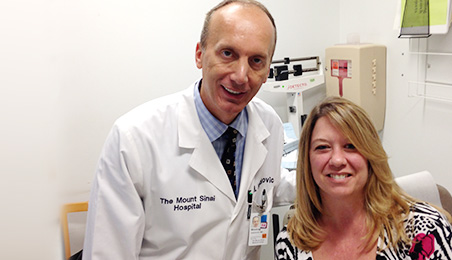Cervical Dystonia: A Painful Pulling and Twisting of the Head and Neck Treated by the Movement Disorder Specialists at Mount Sinai
Jennifer Hickey, a hospital administrator living on Long Island, began to notice that her head was being involuntarily pulled back and turned to one side. She found herself staring up at the ceiling and in severe pain that she describes as “feeling as if a hot iron was being held on my shoulders. By the end of each day, I was having headaches, jaw pain, and vertigo from trying to compensate for my strange head posture. I really didn’t know what was wrong with me!”
 With her symptoms worsening, Jennifer went to see a physiatrist, a physician specializing in Physical Medicine and Rehabilitation. The physiatrist told Jennifer that her neck movements were “dystonic” and her immediate response was: “Dystonic…sounds like demonic. And that’s exactly how it felt, like someone was pulling my head back and I was constantly trying to fight them.” Her next visit was to a neurologist, who confirmed that she indeed had dystonia, a movement disorder that manifests in twisting, turning, and often painful postures. Her form of dystonia is termed “cervical dystonia” because it affects the muscles around and near the cervical (neck) spine. Cervical dystonia is also referred to “spasmodic torticollis.” That physician prescribed several oral medications, including pain killers and muscle relaxants, and was told “dystonia is a life-long disease with no cure.”
With her symptoms worsening, Jennifer went to see a physiatrist, a physician specializing in Physical Medicine and Rehabilitation. The physiatrist told Jennifer that her neck movements were “dystonic” and her immediate response was: “Dystonic…sounds like demonic. And that’s exactly how it felt, like someone was pulling my head back and I was constantly trying to fight them.” Her next visit was to a neurologist, who confirmed that she indeed had dystonia, a movement disorder that manifests in twisting, turning, and often painful postures. Her form of dystonia is termed “cervical dystonia” because it affects the muscles around and near the cervical (neck) spine. Cervical dystonia is also referred to “spasmodic torticollis.” That physician prescribed several oral medications, including pain killers and muscle relaxants, and was told “dystonia is a life-long disease with no cure.”
Movement Disorders: Often Painful, Debilitating Neurologic Conditions
Cervical dystonia is just one of many neurologic conditions described as “movement disorders.” Along with other disorders such as Parkinson’s disease and essential tremor, movement disorders are associated with a miscommunication between the brain and the muscles. For Jennifer, cervical dystonia proved to be extremely debilitating, the pain excruciating, and the impact on her everyday activities was extreme. When asked, she shares how her life was affected by dystonia: “It was difficult for me to brush my teeth without choking and blow drying my hair was a task in and of itself.”
Working Together to Define and Meet Treatment Goals: Result is a Better Quality of Life
Jennifer searched for more information about cervical dystonia and discovered that the most effective treatment is botulinum toxin injections into the affected muscles. She traveled to Manhattan to see a movement disorder specialist and received the injections that temporarily lessened her dystonic symptoms. Not totally satisfied with the results of her treatment, Jennifer scheduled an appointment with a movement disorder specialist in the Robert and John M. Bendheim Parkinson and Movement Disorders Center at Mount Sinai. That was in 2009, and today she is cared for by Miodrag Velickovic, MD, who states, “From the start, it has been very important to me to include Jennifer in the decision-making process. Cervical dystonia, like many movement disorders, is a chronic condition for which we have no cure. That means her treatment may change over time, and we must work together to set goals and achieve the very best outcome.”
A Knowledgeable and Dedicated Physician is the Key to Improved Outcomes
“Dr. Velickovic has given me my life back!” says Jennifer. “Although dystonia never goes away and we are treating the symptoms, Dr. Velickovic’s injection technique and knowledge of cervical dystonia and its treatment are beyond commendable. He is soft-spoken, compassionate, and extremely respectful. Dr. Velickovic is available whenever I am in need. His participation in educational workshops for physicians and other dystonia advocacy activities demonstrate his commitment.”
When asked how her life has changed since receiving care at the Robert and John M. Bendheim Parkinson and Movement Disorders Center, Jennifer replies, “I no longer wake up worrying if I am going to be able to continue working or how I am going to manipulate the stairs. I can go shopping and people don’t stare at me like I am broken. I am so grateful for the expertise of the movement disorder specialists. Without them my quality of life would not be what it is today.”